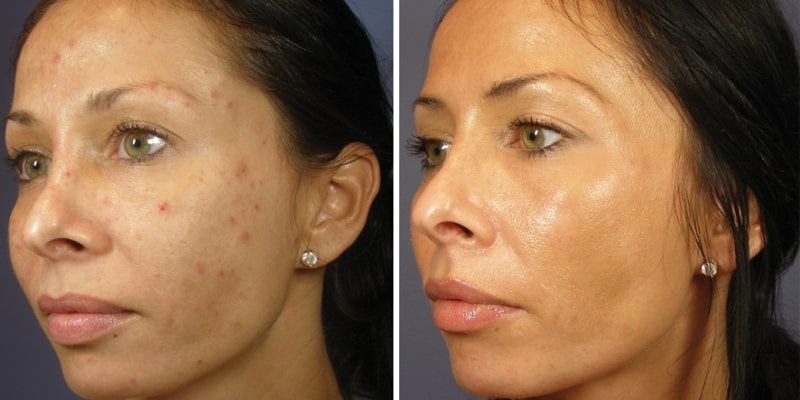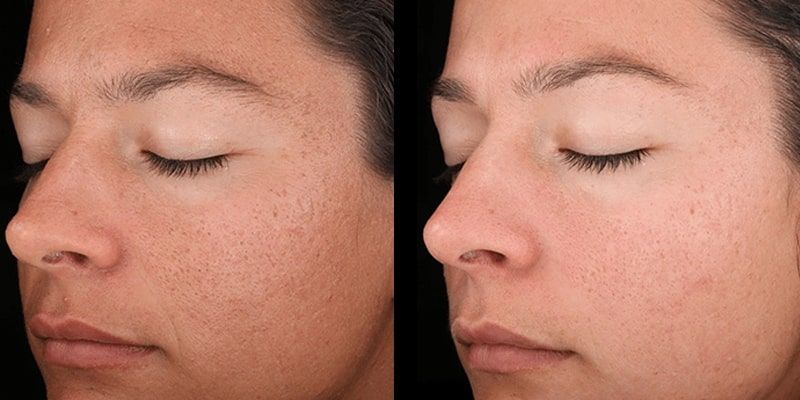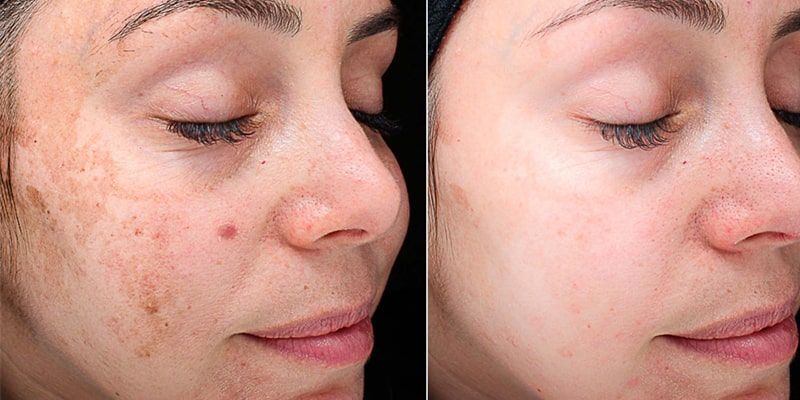Article Feature
Article Feature
Chemical Peels for Treating Light and Dark Skin Tones - How to find the Best Spa for Chemical Peels in NYC.
Chemical Peels for Treating Light and Dark Skin Tones - How to find the Best Spa for Chemical Peels in NYC
Chemical peels have long been a trusted solution for revitalizing the skin, improving texture, fading discoloration, and minimizing signs of aging. But as the skincare world becomes more inclusive, it’s critical to recognize that not all peels are one-size-fits-all. Light and dark skin tones require different approaches to ensure safety and effectiveness. Understanding which peels work best for various skin types can make all the difference in achieving radiant, even-toned skin without complications.
Understanding Chemical Peels
A chemical peel is a skincare treatment that uses acids to exfoliate the skin and remove damaged outer layers. They come in three main categories: superficial (light), medium, and deep peels. Superficial peels typically use alpha hydroxy acids (AHAs) like glycolic acid or beta hydroxy acids (BHAs) like salicylic acid. Medium-depth peels often use trichloroacetic acid (TCA), and deep peels may involve phenol.
Each type of peel penetrates the skin to different depths, and the right choice depends on the individual's skin concern, skin tone, and history of hyperpigmentation.
Why Skin Tone Matters
Light skin tones (Fitzpatrick types I-III) generally tolerate a broader range of peels, including deeper peels, with minimal risk. In contrast, darker skin tones (Fitzpatrick types IV-VI) are more prone to side effects such as post-inflammatory hyperpigmentation (PIH), scarring, and hypopigmentation when exposed to aggressive exfoliation or strong acids.
That’s why selecting the right chemical peel for your skin tone is essential. At Spark Laser Center and Medical Spa we use a tailored approach which ensures effective treatment of acne, melasma, fine lines, and uneven texture—without the risk of damaging melanin-rich skin.
Best Chemical Peels for Light Skin Tones
- Glycolic Acid Peel (AHA)
- Strength: Light to medium
- Benefits: Excellent for treating sun damage, mild wrinkles, and dullness.
- Why it works: Glycolic acid has a small molecular size, allowing it to penetrate deeply and exfoliate effectively. Light skin tones usually tolerate this acid well, even at higher concentrations.
- TCA Peel (Medium Depth)
- Strength: Medium
- Benefits: Improves pigmentation, scarring, and more pronounced fine lines.
- Why it works: TCA peels offer dramatic improvement with manageable downtime. Ideal for those seeking noticeable skin rejuvenation.
- Jessner’s Peel
- Strength: Medium
- Benefits: A blend of salicylic acid, lactic acid, and resorcinol; effective for acne, uneven tone, and texture.
- Why it works: Well-tolerated in lighter skin types, this peel offers strong exfoliation without extreme peeling or redness.
- Phenol Peel
- Strength: Deep
- Benefits: Corrects deep wrinkles, sun damage, and severe texture irregularities.
- Caution: This peel is only recommended for fair skin tones, as it can cause hypopigmentation in darker skin.
Best Chemical Peels for Dark Skin Tones
- Mandelic Acid Peel (AHA)
- Strength: Light
- Benefits: Ideal for treating hyperpigmentation, acne, and dullness in melanin-rich skin.
- Why it works: Mandelic acid penetrates slowly and is gentle on the skin, minimizing irritation and the risk of PIH.
- Lactic Acid Peel
- Strength: Light
- Benefits: Hydrating, brightening, and safe for sensitive skin.
- Why it works: As a milder AHA, lactic acid peels are less likely to trigger inflammation, making them perfect for darker skin tones.
- Salicylic Acid Peel (BHA)
- Strength: Light to medium
- Benefits: Unclogs pores, treats acne, and reduces oiliness.
- Why it works: Oil-soluble and anti-inflammatory, salicylic acid is safe for deeper skin tones and effectively targets acne without compromising pigmentation.
- Modified Jessner’s Peel (without resorcinol)
- Strength: Light to medium
- Benefits: Evens skin tone and improves mild pigmentation issues.
- Why it works: Removing resorcinol makes this peel safer for darker complexions while still providing strong exfoliation.
Best Chemical Peels for all Skin Tones: The VI Chemical Peel
The VI Peel is a medical-grade chemical peel that offers powerful skin rejuvenation with minimal downtime. Suitable for all skin types and tones, it effectively treats acne, sun damage, hyperpigmentation, and fine lines. Its unique blend of ingredients—including TCA, retinoic acid, salicylic acid, phenol, and vitamin C—stimulates collagen production and accelerates cellular turnover. Clients typically experience brighter, smoother, and clearer skin after just one treatment. The VI Peel is especially beneficial for melanin-rich skin, as it reduces dark spots without causing hypopigmentation. With consistent use, it promotes a youthful, even complexion and improves overall skin texture and tone.
Chemical peels have long been a trusted solution for revitalizing the skin, improving texture, fading discoloration, and minimizing signs of aging. But as the skincare world becomes more inclusive, it’s critical to recognize that not all peels are one-size-fits-all. Light and dark skin tones require different approaches to ensure safety and effectiveness. Understanding which peels work best for various skin types can make all the difference in achieving radiant, even-toned skin without complications.
Understanding Chemical Peels
A chemical peel is a skincare treatment that uses acids to exfoliate the skin and remove damaged outer layers. They come in three main categories: superficial (light), medium, and deep peels. Superficial peels typically use alpha hydroxy acids (AHAs) like glycolic acid or beta hydroxy acids (BHAs) like salicylic acid. Medium-depth peels often use trichloroacetic acid (TCA), and deep peels may involve phenol.
Each type of peel penetrates the skin to different depths, and the right choice depends on the individual's skin concern, skin tone, and history of hyperpigmentation.
Why Skin Tone Matters
Light skin tones (Fitzpatrick types I-III) generally tolerate a broader range of peels, including deeper peels, with minimal risk. In contrast, darker skin tones (Fitzpatrick types IV-VI) are more prone to side effects such as post-inflammatory hyperpigmentation (PIH), scarring, and hypopigmentation when exposed to aggressive exfoliation or strong acids.
That’s why selecting the right chemical peel for your skin tone is essential. At Spark Laser Center and Medical Spa we use a tailored approach which ensures effective treatment of acne, melasma, fine lines, and uneven texture—without the risk of damaging melanin-rich skin.
Best Chemical Peels for Light Skin Tones
- Glycolic Acid Peel (AHA)
- Strength: Light to medium
- Benefits: Excellent for treating sun damage, mild wrinkles, and dullness.
- Why it works: Glycolic acid has a small molecular size, allowing it to penetrate deeply and exfoliate effectively. Light skin tones usually tolerate this acid well, even at higher concentrations.
- TCA Peel (Medium Depth)
- Strength: Medium
- Benefits: Improves pigmentation, scarring, and more pronounced fine lines.
- Why it works: TCA peels offer dramatic improvement with manageable downtime. Ideal for those seeking noticeable skin rejuvenation.
- Jessner’s Peel
- Strength: Medium
- Benefits: A blend of salicylic acid, lactic acid, and resorcinol; effective for acne, uneven tone, and texture.
- Why it works: Well-tolerated in lighter skin types, this peel offers strong exfoliation without extreme peeling or redness.
- Phenol Peel
- Strength: Deep
- Benefits: Corrects deep wrinkles, sun damage, and severe texture irregularities.
- Caution: This peel is only recommended for fair skin tones, as it can cause hypopigmentation in darker skin.
Best Chemical Peels for Dark Skin Tones
- Mandelic Acid Peel (AHA)
- Strength: Light
- Benefits: Ideal for treating hyperpigmentation, acne, and dullness in melanin-rich skin.
- Why it works: Mandelic acid penetrates slowly and is gentle on the skin, minimizing irritation and the risk of PIH.
- Lactic Acid Peel
- Strength: Light
- Benefits: Hydrating, brightening, and safe for sensitive skin.
- Why it works: As a milder AHA, lactic acid peels are less likely to trigger inflammation, making them perfect for darker skin tones.
- Salicylic Acid Peel (BHA)
- Strength: Light to medium
- Benefits: Unclogs pores, treats acne, and reduces oiliness.
- Why it works: Oil-soluble and anti-inflammatory, salicylic acid is safe for deeper skin tones and effectively targets acne without compromising pigmentation.
- Modified Jessner’s Peel (without resorcinol)
- Strength: Light to medium
- Benefits: Evens skin tone and improves mild pigmentation issues.
- Why it works: Removing resorcinol makes this peel safer for darker complexions while still providing strong exfoliation.
Best Chemical Peels for all Skin Tones: The VI Chemical Peel
The VI Peel is a medical-grade chemical peel that offers powerful skin rejuvenation with minimal downtime. Suitable for all skin types and tones, it effectively treats acne, sun damage, hyperpigmentation, and fine lines. Its unique blend of ingredients—including TCA, retinoic acid, salicylic acid, phenol, and vitamin C—stimulates collagen production and accelerates cellular turnover. Clients typically experience brighter, smoother, and clearer skin after just one treatment. The VI Peel is especially beneficial for melanin-rich skin, as it reduces dark spots without causing hypopigmentation. With consistent use, it promotes a youthful, even complexion and improves overall skin texture and tone.
What you should look for when choosing a Medical Spa for your Chemical Peel
When treating diverse skin tones, it's not just about selecting the right acid—timing, layering, and concentration matter. At Spark Laser Center and Medical Spa our experienced providers have over a decade of experience in treating a diverse range of skin tones and textures. We often start clients with a series of light peels to gradually build up tolerance, rather than diving into aggressive treatments that risk complications. Pre-peel skin prep is crucial, especially for darker skin. Products like hydroquinone or azelaic acid may be used prior to a peel to reduce melanin activity and prevent PIH. Post-peel care is equally vital and should include sunscreen, hydrating serums, and avoidance of exfoliants until the skin fully heals.
Medical Spa vs. At-Home Peels
While at-home peels have grown in popularity, especially with the rise of products in the market, they are not strong enough to effect a significant change nor are they suitable for every skin type or condition, —particularly when dealing with darker skin tones or deeper skin issues. A licensed provider can assess your skin accurately, adjust peel strength, and monitor your progress to ensure safe and effective results.
Final Thoughts
Chemical peels remain one of the most effective and versatile treatments for achieving smoother, clearer, and more even-toned skin. However, the best chemical peel isn’t just about the ingredients—it’s about the individual. Skin tone, texture, and sensitivity all play a role in selecting the safest and most beneficial option.
For those with lighter skin tones, a broader range of peels can be safely explored, from glycolic to TCA. For darker skin, gentler options like mandelic, lactic, and salicylic acid, offer excellent results with less risk of pigmentation changes.
No matter your skin tone, the key to successful chemical peel treatment is a personalized plan, professional guidance, and a commitment to aftercare. With the right peel and provider, every complexion can glow with confidence.
Chemical Peel Treatments Near Me - Chemical Peels in New York City
Spark Laser Center and Medical Spa offers the Gold Standard for Chemical Peels in New York City, and is widely recognized as New York City's Best Chemical Peel Destination. Spark Laser Center and Medical Spa is conveniently located in Mid-town Manhattan at 119 West 57th Street, Suite 1101 New York, NY 10019. They are accessible by phone 212-245-0940 or email.
Spark Laser Center and Medical Spa offers clients a Complimentary Consultation. Completely free of charge, Sparks knowledgeable staff will assess your skin's condition, and skincare goals and will create a tailored program to optimize results.
Chemical Peels Before and After Photos
Courtesy of Spark Laser Center and Medical Spa

What you should look for when choosing a Medical Spa for your Chemical Peel
When treating diverse skin tones, it's not just about selecting the right acid—timing, layering, and concentration matter. At Spark Laser Center and Medical Spa our experienced providers have over a decade of experience in treating a diverse range of skin tones and textures. We often start clients with a series of light peels to gradually build up tolerance, rather than diving into aggressive treatments that risk complications. Pre-peel skin prep is crucial, especially for darker skin. Products like hydroquinone or azelaic acid may be used prior to a peel to reduce melanin activity and prevent PIH. Post-peel care is equally vital and should include sunscreen, hydrating serums, and avoidance of exfoliants until the skin fully heals.
Medical Spa vs. At-Home Peels
While at-home peels have grown in popularity, especially with the rise of products in the market, they are not strong enough to effect a significant change nor are they suitable for every skin type or condition, —particularly when dealing with darker skin tones or deeper skin issues. A licensed provider can assess your skin accurately, adjust peel strength, and monitor your progress to ensure safe and effective results.
Final Thoughts
Chemical peels remain one of the most effective and versatile treatments for achieving smoother, clearer, and more even-toned skin. However, the best chemical peel isn’t just about the ingredients—it’s about the individual. Skin tone, texture, and sensitivity all play a role in selecting the safest and most beneficial option.
For those with lighter skin tones, a broader range of peels can be safely explored, from glycolic to TCA. For darker skin, gentler options like mandelic, lactic, and salicylic acid, offer excellent results with less risk of pigmentation changes.
No matter your skin tone, the key to successful chemical peel treatment is a personalized plan, professional guidance, and a commitment to aftercare. With the right peel and provider, every complexion can glow with confidence.
Chemical Peel Treatments Near Me - Chemical Peels in New York City
Spark Laser Center and Medical Spa offers the Gold Standard for Chemical Peels in New York City, and is widely recognized as New York City's Best Chemical Peel Destination. Spark Laser Center and Medical Spa is conveniently located in Mid-town Manhattan at 119 West 57th Street, Suite 1101 New York, NY 10019. They are accessible by phone 212-245-0940 or email.
Spark Laser Center and Medical Spa offers clients a Complimentary Consultation. Completely free of charge, Sparks knowledgeable staff will assess your skin's condition, and skincare goals and will create a tailored program to optimize results.
















